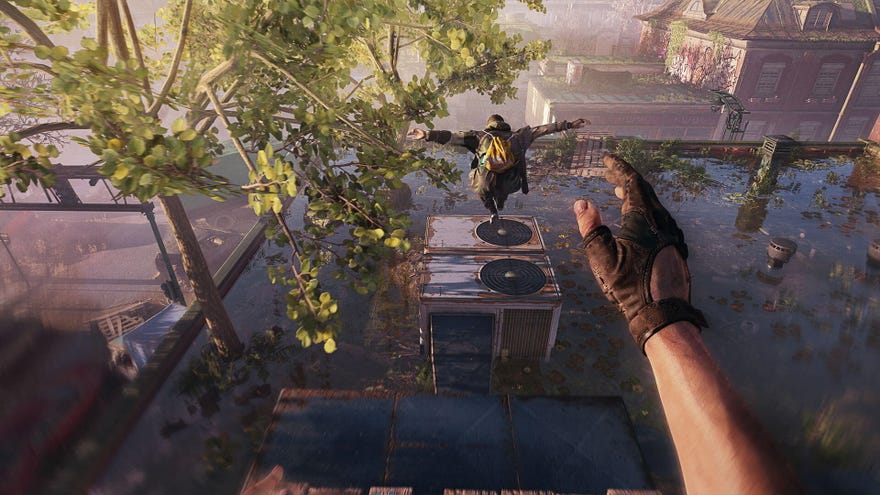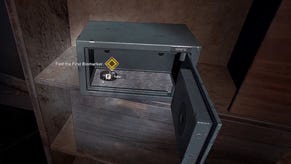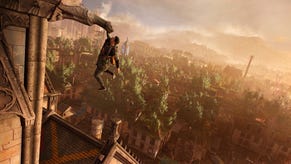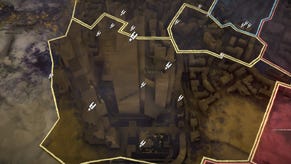There's a spiritual Mirror's Edge sequel awaiting in Dying Light 2
Gravity’s runbow
Just for a second, as you hit the apex of a particularly audacious jump, the bottom end of Dying Light 2’s audio drops out. It’s as if bass were a grounded concept you’d momentarily left behind - an earthy comfort for mortals. Then the tumble begins, and you’d better have already picked out a nice, safe spot to land. This is the irresistible dichotomy of the parkour game, as first defined by Mirror’s Edge in 2008 - an invitation to soar, with the understanding that true freedom doesn’t come for free. Height is earned, momentum is managed, and mistakes are punished with a 30 foot plunge.
Perhaps you’ve seen footage of Dying Light 2’s rooftop running and wondered, “How much of that is me?” In a medium where climbing systems are typically automated rather than simulated, and first-person control tends to end at the waist, it’s natural to suspect that what you’re seeing is a fancy set of animations, triggered by pointing your character in a given direction and holding down the parkour key. I’m here to tell you that Dying Light 2 is not that game: it’s the real deal. It is, among many other things, Mirror’s Edge.
Oh sure, to begin with Dying Light 2 looks streamlined, stripped back - oversimplified, even. A set of contextual ledge grabs, bar-swings and pole shuffles built around a single jump button, albeit one that can be coaxed into sending varying levels of power to your legs. But head to the skill tree, and you’ll see it’s all there: the classic Mirror’s Edge moveset. The wall run, the slide, the tuck-and-roll that breaks a hard landing. The ability to use any low-level obstacle as a springboard, and to gain extra impetus from slopes or rebounds. Momentum is everything - easily interrupted, but deeply satisfying to nurse and protect, like a tiny flame in a gale, by chaining these skills together.
There are a couple of fun additions, too, which you can engage with or not depending on your commitment to reality: a 180-degree midair turn, and a ‘dash’, comparable to Mirror’s Edge Catalyst’s ‘shift’, which gives you a brief second wind when activated on a long straight. Here, though, it’s more involved - pulling energy from your stamina bar, which might be better saved for an upcoming climb. Though the sense of flow is transportive, even meditative, this is parkour as spatial puzzle - constantly engaging your brain as a kind of environmental scanner.

My sense, as a player who has put dozens of hours into both Dying Light 2 and the Mirror’s Edge games, is that this process is more creative than mere problem solving. The game may set the tempo and key, defining the limits of the space and marking out your run with checkpoints that must be hit. But you are the soloist. You choose whether to go high or low, to bounce over or slide under. You decide when to go off-beat, opening your chute to shave off a corner, and when to take an unexpected route around the chords picked out for you. So long as you find your way back by the end of the phrase, it’s all good. That’s jazz, baby.

The best place to do this kind of compositional running in Dying Light 2 - to become Miles-Walked Davis - is in the game’s parkour challenges. There, Techland deletes the zombies from the map for a few minutes and, let’s not pussyfoot around this, completely rips off the running genre’s best format.
These are what the original Mirror’s Edge referred to as Time Trials, and Catalyst called Dashes - checkpoint runs against the clock, judged according to a three tier rating system. Most last a minute and a half at most, once mastered; some, like the formidable Nightrunner Trial X, are 45-checkpoint gauntlets that test endurance and consistency. The latter are only made feasible by a treacly, Titanfall-esque arc to your jumps - a significant gravitational difference between Dying Light 2 and Mirror’s Edge that gives you just a little leeway to steer yourself home. Still, those gauntlets test you - as does the lack of an instant reset button. In the end, you reach a form of virtuosity, finding a way across every roof that is both functional and expressive.
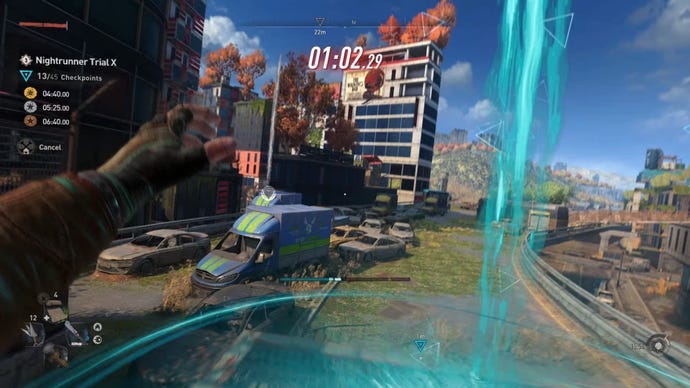
Of course, Dying Light 2 isn’t only its parkour trials. It’s an Everything Game, stuffed with mechanics beyond counting, gleaned from the AAA industry at large. Some of those systems wind up impacting the running in significant ways. The paraglider is one example; the grappling hook another. You might say that they subtract from the parkour, since they encourage you to spend less time running, and don’t really allow you to opt out; many challenge times are only possible to hit with a chunk of airtime.
But I’ve found Techland’s traversal tools to be complementary, since they’re built with that familiar philosophy of earned momentum, of freedom with the threat of a long fall. The paraglider isn’t an easy means of seeing Villedor via an unlocked camera. Instead, it’s a kite to be wrestled with, its use limited by the same pool of stamina needed for everything else. Its effective deployment requires just as much forethought as scaling the side of a cathedral.
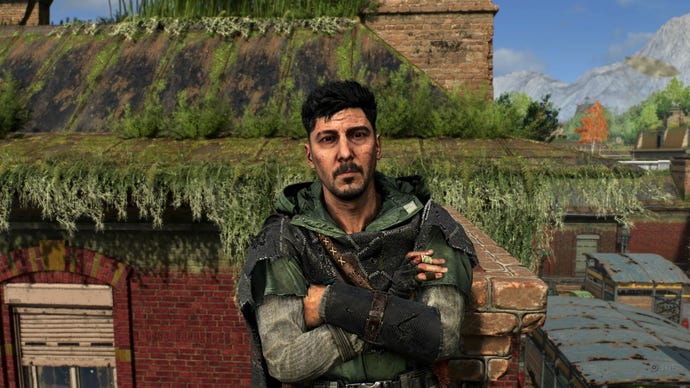
There’s real joy to be found in folding these tools into your existing catalogue of leaps and bounds, such that each enhances the other. Sustained momentum from a jump can propel the paraglider across greater gaps, and on the other end of your flight, a smooth landing can power you forward yet again. There’s nothing like cutting your canopy as you come through a gaping tenth floor window in Villedor’s central district and hitting the dusty office floor at a sprint. Get it right, and protagonist Aiden will let out a gleeful cackle. I know, mate. The post-apocalyse is ace.
The first character you get to know in Dying Light 2 is Hakon, a runner played by David Belle - aka the pioneer of parkour. And the first character you get to know in Mirror’s Edge Catalyst is a fellow courier named Icarus. It’s a fitting moniker - a reminder that, while you’re invited to soar in these games, true freedom doesn’t come for free.
